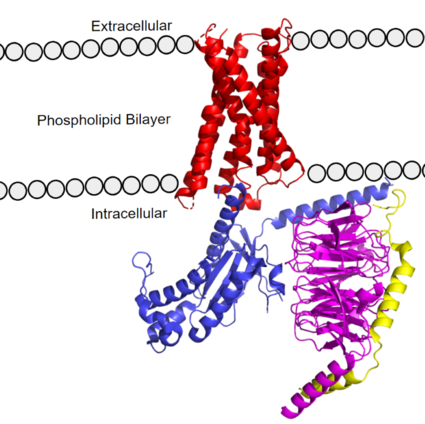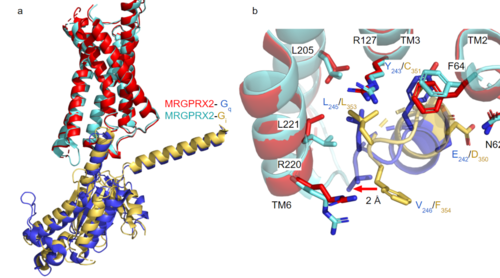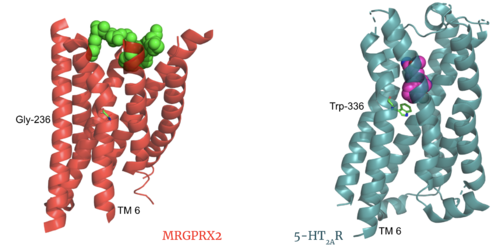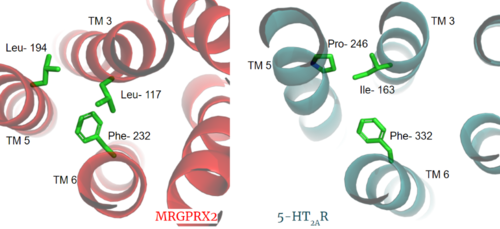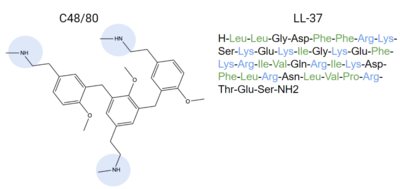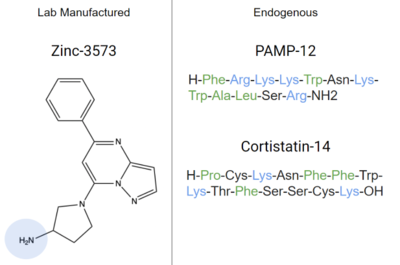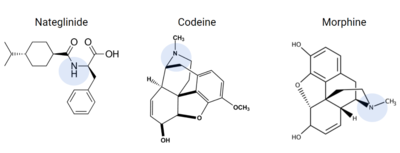Sandbox Reserved 1701
From Proteopedia
(Difference between revisions)
| Line 106: | Line 106: | ||
=== Clinical Relevance === | === Clinical Relevance === | ||
[[Image:Screen Shot 2022-04-162 at 2.49.26 PM.png|420px|right|thumb|'''Figure 11.'''Schematic representation of cellular response]] | [[Image:Screen Shot 2022-04-162 at 2.49.26 PM.png|420px|right|thumb|'''Figure 11.'''Schematic representation of cellular response]] | ||
| - | Some cells in the human body that express the MRGPRX2 receptor include mast cells in the skin, intestines, and trachea <ref name= "Porebski">PMID: 30619367</ref>. Mast cells are involved in allergic responses by their release of histamine or other inflammatory chemicals in the body. <ref name="McNeil">PMID: 25517090</ref> These responses induce common allergic reaction and anaphylaxis symptoms, such as cutaneous itching sensations or airway constriction | ||
| - | <ref name= "Cao" /><ref name= "Yang" /><ref name="McNeil">PMID: 25517090</ref>. Mast cells can be activated by either antibodies in the human immune response or upon ligands binding to their MRGPRX2 receptors <ref name= "McNeil" />. Ligands that bind to MRGPRX2 in the natural environment to produce an allergic response include some contents of insect venom, molecules like C48/80 or other polycationic molecules. They can also respond to endogenous signaling molecules involved in inflammation pathways and immune responses such as cytokines, anaphylatoxins, or neuropeptides <ref name= "Porebski" />. Binding to MRGPRX2 triggers an intracellular signaling pathway that eventually leads to mast cells releasing their contents containing histamine, cytokines, or other inflammatory molecules that may go on to trigger the itching sensation <ref name= "Cao" /> <ref name= "Yang" />. | ||
| - | Many medications commonly list chronic skin itching or inflammatory responses as side effects, such as nateglinide, an anti-diabetic drug <ref name= "Cao" />. Upon analysis of some medications that list itching as side effects such as nateglinide, they structurally share many similarities to known MRGPRX2 ligands, and could therefore initiate an unwanted itch response in patients. Other drugs such as morphine or codeine also share structural features to known MRGPRX2 ligands, which can contribute to itching side effects seen in users of these drugs <ref name= "Cao" />. | ||
| - | + | [[Image:Activating_drugs.png |400px|right|thumb|'''Figure 9.''' Common prescriptions that are tied to adverse itching side effects include nateglinide, morphine, and codeine. These drugs have structural similarities to known ligands for the MRGPRX2 receptor, and can lead to MRGPRX2 activation.]] | |
| - | + | Many medications commonly list chronic skin itching or inflammatory responses as side effects, such as [https://pubchem.ncbi.nlm.nih.gov/compound/Nateglinide nateglinide], an anti-diabetic drug <ref name= "Cao" />. Other prescribed medications that list itching as a possible side effect are [https://pubchem.ncbi.nlm.nih.gov/compound/Atracurium#section=2D-Structure Atracurium], [https://pubchem.ncbi.nlm.nih.gov/compound/441290 Rocuronium], [https://pubchem.ncbi.nlm.nih.gov/compound/2764 Ciprofloxacin], and [https://pubchem.ncbi.nlm.nih.gov/compound/149096 Levofloxacin]<ref name="Navines-Ferrer">PMID:30072729</ref>, all of which are tied to MRGPRX2 activation. | |
| + | Other drugs that have been known to trigger allergic reactions and even anaphylactic responses are opioids [https://pubchem.ncbi.nlm.nih.gov/compound/Morphine morphine] or [https://pubchem.ncbi.nlm.nih.gov/compound/5284371 codeine]<ref name= "Cao" />, which could explain anaphylactic responses to anesthetics seen in some patients<ref name="McNeil" />. Upon analysis of these drugs, they share many structural similarities that are known to bind to the sub-pockets in MRGPRX2, shown in '''Figure 9''', which is a possible explanation for the unwanted itch and inflammation responses produced in some patients when administering these drugs <ref name="McNeil" /><ref name= "Cao" />. | ||
| + | |||
| + | Possible treatments for these unwanted side effects of drugs can be developed by understanding the mechanism of the MRGPRX2 receptor. Research on Cortistatin-14, an endogenous neuropeptide ('''Figure 7'''), has shown that it has anti-inflammatory properties because of how it binds to the MRGPRX2 receptor <ref name= "Gonzalez-Rey">PMID: 16492802</ref>. Additionally, [https://pubchem.ncbi.nlm.nih.gov/compound/Osthole Osthole], an extract from [https://en.wikipedia.org/wiki/Cnidium_monnieri Cnidium monnieri plants], also known as Monnier's snow parsley, demonstrates similar MRGPRX2 inhibition because of its structural similarity to many known ligands for this receptor, and could possibly be used as a treatment option for adverse allergic reactions to commonly prescribed drugs<ref name= "Dondalska" />. More research on MRGPRX2 can open the door for the development of drugs that avoid activation of the MRGPRX2 receptor, or possible treatments for excessive inflammation and allergic reactions. | ||
== 3D Structures == | == 3D Structures == | ||
Revision as of 23:45, 18 April 2022
MRGPRX2 Human Itch G-Protein Coupled Receptor (GPCR)
| |||||||||||
References
- ↑ Tuteja N. Signaling through G protein coupled receptors. Plant Signal Behav. 2009 Oct;4(10):942-7. doi: 10.4161/psb.4.10.9530. Epub 2009, Oct 14. PMID:19826234 doi:http://dx.doi.org/10.4161/psb.4.10.9530
- ↑ Hauser AS, Attwood MM, Rask-Andersen M, Schioth HB, Gloriam DE. Trends in GPCR drug discovery: new agents, targets and indications. Nat Rev Drug Discov. 2017 Dec;16(12):829-842. doi: 10.1038/nrd.2017.178. Epub, 2017 Oct 27. PMID:29075003 doi:http://dx.doi.org/10.1038/nrd.2017.178
- ↑ 3.0 3.1 3.2 Porebski G, Kwiecien K, Pawica M, Kwitniewski M. Mas-Related G Protein-Coupled Receptor-X2 (MRGPRX2) in Drug Hypersensitivity Reactions. Front Immunol. 2018 Dec 20;9:3027. doi: 10.3389/fimmu.2018.03027. eCollection, 2018. PMID:30619367 doi:http://dx.doi.org/10.3389/fimmu.2018.03027
- ↑ 4.0 4.1 4.2 4.3 4.4 4.5 4.6 Dondalska A, Ronnberg E, Ma H, Palsson SA, Magnusdottir E, Gao T, Adam L, Lerner EA, Nilsson G, Lagerstrom M, Spetz AL. Amelioration of Compound 48/80-Mediated Itch and LL-37-Induced Inflammation by a Single-Stranded Oligonucleotide. Front Immunol. 2020 Sep 30;11:559589. doi: 10.3389/fimmu.2020.559589. eCollection, 2020. PMID:33101278 doi:http://dx.doi.org/10.3389/fimmu.2020.559589
- ↑ 5.0 5.1 5.2 5.3 5.4 5.5 5.6 McNeil BD, Pundir P, Meeker S, Han L, Undem BJ, Kulka M, Dong X. Identification of a mast-cell-specific receptor crucial for pseudo-allergic drug reactions. Nature. 2015 Mar 12;519(7542):237-41. doi: 10.1038/nature14022. Epub 2014 Dec 17. PMID:25517090 doi:http://dx.doi.org/10.1038/nature14022
- ↑ 6.00 6.01 6.02 6.03 6.04 6.05 6.06 6.07 6.08 6.09 6.10 6.11 Cao C, Kang HJ, Singh I, Chen H, Zhang C, Ye W, Hayes BW, Liu J, Gumpper RH, Bender BJ, Slocum ST, Krumm BE, Lansu K, McCorvy JD, Kroeze WK, English JG, DiBerto JF, Olsen RHJ, Huang XP, Zhang S, Liu Y, Kim K, Karpiak J, Jan LY, Abraham SN, Jin J, Shoichet BK, Fay JF, Roth BL. Structure, function and pharmacology of human itch GPCRs. Nature. 2021 Dec;600(7887):170-175. doi: 10.1038/s41586-021-04126-6. Epub 2021, Nov 17. PMID:34789874 doi:http://dx.doi.org/10.1038/s41586-021-04126-6
- ↑ 7.0 7.1 7.2 7.3 7.4 7.5 7.6 7.7 7.8 Yang F, Guo L, Li Y, Wang G, Wang J, Zhang C, Fang GX, Chen X, Liu L, Yan X, Liu Q, Qu C, Xu Y, Xiao P, Zhu Z, Li Z, Zhou J, Yu X, Gao N, Sun JP. Structure, function and pharmacology of human itch receptor complexes. Nature. 2021 Dec;600(7887):164-169. doi: 10.1038/s41586-021-04077-y. Epub 2021, Nov 17. PMID:34789875 doi:http://dx.doi.org/10.1038/s41586-021-04077-y
- ↑ Kamato D, Thach L, Bernard R, Chan V, Zheng W, Kaur H, Brimble M, Osman N, Little PJ. Structure, Function, Pharmacology, and Therapeutic Potential of the G Protein, Galpha/q,11. Front Cardiovasc Med. 2015 Mar 24;2:14. doi: 10.3389/fcvm.2015.00014. eCollection, 2015. PMID:26664886 doi:http://dx.doi.org/10.3389/fcvm.2015.00014
- ↑ Trzaskowski B, Latek D, Yuan S, Ghoshdastider U, Debinski A, Filipek S. Action of molecular switches in GPCRs--theoretical and experimental studies. Curr Med Chem. 2012;19(8):1090-109. doi: 10.2174/092986712799320556. PMID:22300046 doi:http://dx.doi.org/10.2174/092986712799320556
- ↑ 10.0 10.1 Katritch V, Fenalti G, Abola EE, Roth BL, Cherezov V, Stevens RC. Allosteric sodium in class A GPCR signaling. Trends Biochem Sci. 2014 May;39(5):233-44. doi: 10.1016/j.tibs.2014.03.002. Epub , 2014 Apr 21. PMID:24767681 doi:http://dx.doi.org/10.1016/j.tibs.2014.03.002
- ↑ Rovati GE, Capra V, Neubig RR. The highly conserved DRY motif of class A G protein-coupled receptors: beyond the ground state. Mol Pharmacol. 2007 Apr;71(4):959-64. doi: 10.1124/mol.106.029470. Epub 2006 Dec , 27. PMID:17192495 doi:http://dx.doi.org/10.1124/mol.106.029470
- ↑ Naranjo AN, Chevalier A, Cousins GD, Ayettey E, McCusker EC, Wenk C, Robinson AS. Conserved disulfide bond is not essential for the adenosine A2A receptor: Extracellular cysteines influence receptor distribution within the cell and ligand-binding recognition. Biochim Biophys Acta. 2015 Feb;1848(2):603-14. doi: 10.1016/j.bbamem.2014.11.010., Epub 2014 Nov 16. PMID:25445670 doi:http://dx.doi.org/10.1016/j.bbamem.2014.11.010
- ↑ Olivella M, Caltabiano G, Cordomi A. The role of Cysteine 6.47 in class A GPCRs. BMC Struct Biol. 2013 Mar 15;13:3. doi: 10.1186/1472-6807-13-3. PMID:23497259 doi:http://dx.doi.org/10.1186/1472-6807-13-3
- ↑ Gonzalez-Rey E, Chorny A, Robledo G, Delgado M. Cortistatin, a new antiinflammatory peptide with therapeutic effect on lethal endotoxemia. J Exp Med. 2006 Mar 20;203(3):563-71. doi: 10.1084/jem.20052017. Epub 2006 Feb, 21. PMID:16492802 doi:http://dx.doi.org/10.1084/jem.20052017
